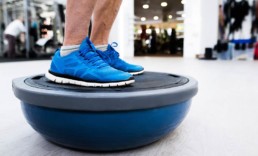Most of us give little thought to walking; it’s movement that seems to come as naturally to us as breathing – except when it doesn’t.
Walking takes strength, balance, sensation and co-ordination. Think about babies: first, they gain enough strength to raise themselves to their hands and knees to crawl. Next, comes pulling themselves up by grabbing a chair. Finally, they merge their newfound strength with co-ordination and manage to propel themselves forward, albeit awkwardly. It takes time and practice for them to find a natural gait.
As adults, we tend to forget how intricate this process is and how easily it can be disrupted. However, normal gait and balance rely on the proper functioning of various body parts, including the ears, eyes, brain, sensory nerves and muscles.
Injuries or problems with any of these parts can result in an inability to balance or to an unsteady gait, which can lead to falls or injuries if the causes and symptoms aren’t addressed.
Common Causes for Abnormal Gait
If an injury or illness has impaired your ability to walk normally, you may need gait training to improve your motion. Potential causes of problems with gait and balance include:
- Aging: With a natural decrease in strength and flexibility comes impairment to your balance.
- Musculoskeletal Problems: If your range of motion, strength, endurance and mobility are impeded for any reason, your gait may be affected, since you need a certain level of balance and strength to walk properly.
- Impaired Cognition: You are less able to adapt to a situation if your judgment or safety awareness decreases, your attention is poor or you process information more slowly than before.
- Impaired Neuromuscular Responses: Disruption in the signals between the brain and the muscles can affect gait and balance. The disruption can result from a variety of issues, such as a stroke, Parkinson’s disease or multiple sclerosis.
- Impaired Sensory Processes: If your body’s sensors are unable to collect information about the environment, it can lead to balance and gait issues. Sensory disabilities may be caused by glaucoma, cataracts or diabetic retinopathy, to name just a few possibilities.
Gait Analysis
Your physiotherapist may diagnose your gait as abnormal after reviewing your medical history, discussing your symptoms and doing a walking gait analysis. She or he may use a gait scan device to assess the biomechanical function of your feet.

Gait and Balance Training
Gait and balance training is a type of physiotherapy that helps you learn to walk normally again. The benefits of gait and balance training include:
- Improving your balance and posture;
- Strengthening your joints and muscles;
- Developing muscle memory;
- Increasing your endurance;
- Retraining your legs to participate in repetitive motion; and
- Increasing your mobility while decreasing the risk of falling.
It also offers other health benefits; because you are mobile rather than stationery, it can improve your overall health, prevent increased osteoporosis and keep heart disease at bay.
Your gait and your balance are inextricably linked, both relying upon the body’s cognitive functions, the eyes, the ears and joints, muscles and nerves. Gait and balance training helps these parts work in harmony.
Gait and balance training is also very helpful to people recovering from a variety of health issues, such as a spinal cord injury, a joint replacement or a stroke. Learning to walk properly again requires determination and practice. Training also helps prevent injury, assists with posture and keeps related aches and pains to a minimum.
Before you start gait and balance training, you must be healthy enough to take part in physical activity and your joints must be strong enough to support you. The activities your physiotherapist will instruct you to do will depend on your diagnosis and physical abilities. Gait training exercises often include walking on a treadmill, combined with strength and mobility exercises.
Orthotics
In addition to your gait and balance training, your physiotherapist may suggest custom orthotics for your shoes. Custom orthotics are not the casual shoe inserts that you can buy at any drugstore to add extra cushioning to your shoes. They are custom-made, prescription medical devices that you wear inside your shoes to correct biomechanical foot issues – unstable or impaired gait when walking or running. These prescription inserts are useful in helping improve your gait and correcting the appropriate problem.
If you’re having trouble walking or are recovering from an injury, it is worthwhile to consider gait and balance training to get you back on your feet and on the right track.
